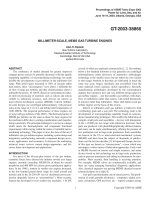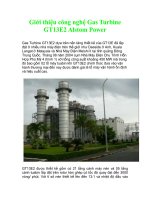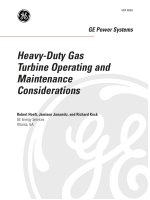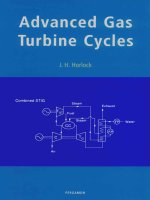Gas turbine theory 10
Bạn đang xem bản rút gọn của tài liệu. Xem và tải ngay bản đầy đủ của tài liệu tại đây (824.41 KB, 51 trang )
PRINCIPLES OF CONTROL SYSTEMS
441
442
PREDICTION OF PERFORMANCE-FURTHER
TOPICS
that the thrust is constant (flat) at all temperatures below the rated
temperature; it is apparent that at the ISA temperature the engine is
thermodynamically capable of considerably higher thrust, referred to as
the thermodynamic rating. If the engine were controlled on the basis of
rotational speed, the maximum speed would only be used at the rated
temperature; on cooler days the required thrust could be obtained at a
reduced speed and turbine inlet temperature. The thermodynamic rating
may be 15-20 per cent higher than the flat rating. One version of the PT-6
turboprop was flat rated at 600 kW to 62·8°C; this very high temperature
was required to provide an engine capable of 600 kW at 12000 m for a
high-speed aircraft. The engine had a thermodynamic rating of 1000kW
but the control system limited the power to 600 kW and the gearbox was
designed to meet this lower rating, saving on weight and cost. It can be
seen that a high flat-rating temperature implies a significant derating of the
engine at ISA conditions.
Control system design is a specialized field which is changing rapidly and
the interested reader must turn to the current literature. The control
designer, in turn, must have a full understanding of the system to be
controlled which necessitates an appreciation of gas turbine performance.
Appendix A
Some notes on gas dynamics
Owing to the increasing tendency towards specialization even at first degree and
diploma level, it may be that some readers will not have been exposed to a course
in gas dynamics. It is hoped that this Appendix will provide them with an adequate
summary of those aspects which are relevant to gas turbine theory, and that it will
serve others as useful revision material.
A.I
Compressibility effects (qualitative treatment)
It is well known that when the relative velocity between a gas and a solid body
reaches a certain value, the flow behaves in a quite different manner to that
expected from a study of hydrodynamics. The effects produced, which manifest
themselves as additional loss of stagnation pressure in the stream, do not arise
when the fluid is a liquid. This suggests that the phenomena are due to the change
in density which accompanies a change in pressure of a gas. The idea is
strengthened by the fact that the phenomena only occur at high speeds when the
pressure changes set up by the relative motion, and therefore the density changes,
become considerable. In consequence, the phenomena here described are known as
compressibility effects.
When, in a mass of gas at rest. a small disturbance results in a slight local rise of
pressure, it can be shown that a pressure wave is propagated throughout the gas
with a velocity which depends upon the pressure and density of the gas. This
velocity is the speed of sound in the gas. or sonic \'elocity a. given by
In all processes related to the propagatIon ot pressure waves, the cnanges taKe
place so rapidly that there is no time for any heat transfer between adjacent layers
of fluid; the processes are therefore adiabatic. Also, when the amplitude of the
pressure wave is small and there is no material alteration in the pressure and
temperature of the gas, as is true of an ordinary sound wave, there is no increase of
entropy. The propagation of a sound wave is therefore not only adiabatic but
isentropic.
Now consider what happens when a similar disturbance occurs in a gas flowing in
one direction with a velocity C. The velocity of propagation of the pressure wave
relative to the gas will still be equal to the speed of sound, a. Relative to a fixed
point, however, say the walls of the passage confining the gas, the speed of
444
APPENDIX A SOME NOTES ON GAS DYNAMICS
propagation will be (a + C) downstream and (a - C) upstream. It follows that if
the velocity of the gas is greater than the sonic velocity, i.e. supersonic, there can
be no propagation of the pressure wave upstream at all. This is the usual physical
explanation given for the existence of a critical condition in nozzle flow. When
once the pressure drop across a nozzle is great enough to cause the gas velocity to
reach the local sonic value, no further decrease in outlet pressure will be
propagated upstream and no further increase in mass flow will be obtained.
Figure A I illustrates the effects just described, and a useful picture to have in mind
is that of the ever-widening circles of ripples formed by a stone thrown into a
pond. When a disturbance, such as an intermittent electric spark, is placed in a gas
stream moving with subsonic velocity (C < a), the radius of a spherical pressure
wave after time t will be at, while the centre of this wave will have moved
downstream a distance Ct. All waves emitted subsequently will lie within the
spherical wave front of this wave, as shown in Fig. AI(a). On the other hand, when
C> a as in Fig. AI(b), the spherical wave fronts will move downstream at a
greater rate than the radii of the waves increase. All the spherical waves will
therefore lie within a cone having its apex at the point of the disturbance.
The effect of a small solid particle placed in a stream of gas is that of a disturbance
emitting pressure waves continuously, so that the spherical wave fronts of
Fig. Al(b) appear as a single conical wave front of semi-angle
is given
hv
So far we have been considering pressure impulses of very small amplitude, such
that there is no permanent change in the pressure and temperature of the gas as the
wave moves through it, and consequently such that there is no change in entropy.
In many practical cases of gas flow relative to a solid body these conditions are not
fulfilled; there is a marked pressure and temperature difference across the wave,
COMPRESSIBILITY EFFECTS (QUALITATIVE TREATMENT)
445
and there is an increase in entropy indicating an irreversible dissipation of kinetic
energy which is manifested by a loss of stagnation pressure. The wave front
represents a discontinuity in the flow. and as the change of pressure is to all intents
and purposes instantaneous, the wave is termed a shock l\"Ql·e. The Mach wave
previously discussed can be regarded as the weakest possible form of shock wave.
The shock wave formed by a projectile travelling at supersonic speed. for example,
is analogous to the bow wave set up by a ship: the water. unable to escape rapidly
enough past the sides of the ship. piles up to form a vee-shaped wave which travels
along with the ship. In the case of the projectile. the air outside the region enclosed
by the conical wave front does not receive a signal warning it of the approach of
the solid object creating the disturbance. and hence the formation of the shock
wave at the nose of the projectile. It must be stressed that it is the relative motion
which is important; it does not matter whether the body or the fluid or both are
movmg.
We have said that there is a pressure difference across a shock wave. We must
now ask whether it is a pressure rise or pressure drop in the direction of gas
flow relative to the body; that is, through the shock wave. Both experiment and
theory indicate that a shock wave can only be formed when a supersonic flow is
decelerated. The velocities in the divergent part of a convergent-divergent nozzle
are supersonic, but if the nozzle is operating at the pressure ratio for which it is
designed no shock waves will be formed because the flow is accelerating under
the influence of the pressure drop. Consider, on the other hand, what happens
when the outlet pressure is appreciably above the value which would give just
the right amount of expansion to suit the outlet area of the nozzle. Under these
conditions the nozzle over-expands the gas so that before the gas can discharge
into the surroundings some recompression and deceleration of the gas must
occur. This recompression can only be brought about by a shock wave in the
divergent part of the nozzle, because a convergent duct is necessary for
isentropic diffusion of a supersonic stream. Figure A2 shows typical pressure
distributions along a nozzle when the outlet pressure is above the design value.
As the outlet pressure is reduced, the plane normal shock wave moves towards
the exit, and further reduction towards the design outlet pressure is
accompanied by a sudden change to a complex system of oblique shock waves
downstream of the exit.
BASIC EQUATIONS FOR STEADY ONE-DIMENSIONAL CO\tPRESSIBLE FLOW
447
the shock wave opposes the direction of flow and consequently. in the boundary
layer where the kinetic energy is small, the shock wave may arrest the motion
altogether. The boundary layer will thicken just in front of the shock waye. and
may break away from the surface at the rear of it. If this breakaway of the
boundary layer occurs, it will result in the initiation of a vortex trail involving
considerable dissipation of energy. This, then, is the reason for the large loss of
stagnation pressure in the wake of the aerofoil, and the reason why the Mach
number of the main stream should be kept below the value likely to cause the
formation of shock waves with this shape of aerofoil.
We may now turn to the mathematical analysis of compressible flow in a few simple.
classical, flow situations. Much of the algebra is too lengthy to be given here. but by
its omission we hope to enable the reader to see the wood: for the trees he or she can
turn to the many excellent standard texts on gas dynamics, e.g. Refs (3) and (4).
A.2
Basic equations for steady one-dimensional compressible
flow of a perfect gas in a duct
A flow can be regarded as one-dimensional
(a)
(b)
(c)
(d)
if
changes in flow area and curvature of the axis are gradual,
all properties are uniform across planes normal to the axis,
any heat transfer per unit mass flow (dQ), across the surface area of the duct
(dS), changes the properties uniformly over the cross-section,
the effect of friction can be represented by a shear stress r at the wall.
The flow is steady if there is no change in the mass flowing per unit time at
successive planes along the duct, and if the properties of the gas at any plane do
not change with time.
Firstly, because we are dealing with a perfect gas we have the equation of state
Secondly, application of the conservation laws yields the following equations in
integral and differential form (see Fig. AS):
Conservation
of mass (continuity equation)
FRICTIONLESS FLOW IN A CONSTANT AREA DUCT \\'lTH HEAT TRANSFER
A.4
451
Frictionless flow in a constant area duct with heat transfer
We have seen that when A is constant and T is zero, heat transfer to the gas causes
a subsonic flow to accelerate towards M = I and a supersonic flow to decelerate
towards M = 1. This idealized flow is referred to as Rayleigh flow. One important
effect, to which reference was made in Chapter 6, is that heat transfer to a subsonic
flow in a duct of constant area must be accompanied by a fall in pressure. The
pressure difference is necessary to provide the force required to accelerate the flow,
i.e. to satisfy the momentum equation.
The relevant equations for a Rayleigh flow from some arbitrary state M, T, etc., to
the state where M = I and quantities are denoted by asterisks, are as follows:
A.6
Plane normal shock waves
When shock waves occur normal to the axis of flow, they are discontinuities which
occupy a finite but very short length of duct as depicted in Fig. A8(a). For this
reason they can be treated as adiabatic frictionless processes in a duct of constant
cross-sectional area. In general, shock waves are formed when the conditions are
such that the three conservation laws cannot be satisfied simultaneously with an
assumption of reversible flow. What has to be relinquished is the idealization of
reversibility, even though the flow is being regarded as frictionless. Then, if the
process is adiabatic, all that the Second Law of Thermodynamics requires is that
there should be an increase in entropy in the direction of flow.
The relevant equations relating properties on either side of a shock wave are
can be obtained
by ordinary subsonic diffusion in a divergent duct. Higher
efficiencies can only be obtained by designing supersonic intakes to operate with a
system of oblique shocks. This type of shock forms the subject of the next section.
The main features of Rayleigh flow, Fanno flow and flow through normal shocks
can be summarized
neatly by drawing the processes on a T-s diagram as in
Fig. A II. Such a diagram is a useful mnemonic. The Fanno and normal shock
processes are shown as dotted lines because they are essentially irreversible
processes. The three lines are all drawn for the same value of mass flow per unit
area (i.e. pC) which we have seen is constant for all three types of flow. This is why
states I and 2 on either side of the normal shock coincide with the points of
intersection
of the Fanno and Rayleigh lines. There are four features which
perhaps are not emphasized sufficiently by notes on the figure. (i) A Fanno process
can occur only from state 2 towards state 3 or from I towards 3. It cannot pass
through 3 without a decrease in entropy which would contravene the Second Law
of Thermodynamics.
(ii) A Rayleigh process can occur between I and 4 in either
direction or between 2 and 4 in either direction, but it cannot proceed through state
4 in either direction. In practice, the picture is modified because friction is present
simultaneously
with heating or cooling; but also it would be physically difficult to
suddenly change from heating to cooling at the point in the duct where the gas
attains state 4 and, without doing so, passage through state 4 would clearly
contravene the Second Law. (iii) It is interesting to note that when a subsonic flow
is heated, the maximum temperature is reached at state 5 (where it can be shown
that M = I/VY), although the stagnation temperature must continue to rise with
energy input until the gas attains state 4. In other words, between 5 and 4 the
density decreases, and hence the velocity increases, at such a rate that the static
458
APPENDIX A SOME NOTES ON GAS DYNAMICS
temperature falls. (iv) When point 3 on the Fanno line or point 4 on the Rayleigh
line is reached the flow is choked, and further friction (i.e. additional length of
pipe), or heating in the case of Rayleigh flow, causes the state to move on to
another Fanno line or another Rayleigh line respectively. M remains equal to
unity. These would be lines appropriate to a reduced mass flow per unit area, and
would lie to the right of those shown because of the increase in entropy due to
additional friction in one case and heating in the other.
A.7
Oblique shock waves
In certain types of supersonic flow, shock waves are formed at an inclination to the
direction of flow as in Fig. A12. Strictly speaking the analysis of such phenomena
involves a study of two-dimensional flow although, as will be made apparent, some
of the equations obtained for plane normal shock waves can be used with a little
modification. The analysis of plane oblique shock waves shows that for any given
incident Mach number,
Oblique shock waves are formed when a body is immersed in a supersonic stream.
If we consider the simple case of a wedge of semi-angle e, two types of flow are
found to occur as depicted in Fig. A13.
with y = I A03 as used in the tables.
Since a pressure ratio of I· 71 is obtainable from a weak plane oblique shock with
an efficiency of 98 per cent, it would appear that a supersonic intake designed to
make use of one or more such shocks might be more efficient than the simple type
of 'pi tot' intake referred to in section A.6; and this has been found to be the case.
In the Oswatitsch intake, which makes use of a conical centre body as shown in
Fig. A 15, the flow is decelerated to a low supersonic velocity by several successive
oblique shocks (two are shown) with the final transition to subsonic velocity taking
place via a normal shock. The main problems in the design of such supersonic
intakes are (a) the establishment of a stable shock pattern insensitive to minor
ISENTROPIC TWO-DIMENSIONAL SUPERSONIC EXPANSION & COMPRESSION
461
changes in the flow downstream (e.g. in the engine), and (b) the maintenance of a
good performance under off-design conditions. For aircraft engine intakes which
have to operate over a complete speed range from M, = 0 to M, » I, variable
geometry is essential. This is accomplished by incorporating an adjustable centre
body and/or cowl, and bleed slots. Figure AI6 illustrates a variable geometry
intake of the 'scoop' type, which is of rectangular cross-section: it may be slung
under the wing or run along the side of the fuselage.
A.8
Isentropic two-dimensional supersonic expansion and
compression
Perhaps the foregoing sections have left the reader with the impression that
isentropic expansion and compression of a supersonic stream is impossible in
principle. A moment's reflection on the existence of successful supersonic aircraft
wings, and efficient nozzles and diffusers for supersonic wind tunnels, should dispel
this illusion. Processes which would be isentropic apart from the effect of viscous
friction are possible if the duct walls, or immersed body as the case may be, are
correctly shaped. Certainly it is possible to avoid the large loss of stagnation
pressure due to breakdown of the flow which was illustrated in Fig. A4.
Consider supersonic flow that is initially parallel to a surface but which encounters a
small change of direction of the surface; it may be a convex or concave deflection as
in Fig. AI7(a) and (b). If the change in direction is infinitesimal, the corner is the
source of an infinitesimal disturbance which is communicated to the main flow
isentropically along a Mach wave. From section A. I we know that this wave will
make an angle J1 = sin-I (11M) with the direction of flow. And from the velocity
triangles of Fig. AI7 we see that the convex corner produces an increase in velocity,
dC, which must be accompanied by a pressure drop dp; while the concave corner
leads to a decrease in velocity, implying a compression.
Any rounded convex corner giving a finite deflection can be regarded as the source
of a series of infinitesimal deflections as illustrated in Fig. AI8(a). The Mach
waves, or characteristic lines as they are often called, diverge and do not interfere
with each other, so permitting the flow to accelerate smoothly and isentropically to
the downstream pressure. In the limit the same thing can occur at a sharp finite
corner: in this case the flow expands smoothly through a fan of Mach waves as
shown in Fig. AI8(b). This is known as Prandtl-Meyer flow, and the evaluation of
finite changes of pressure and Mach number associated with a finite deflection is
possible with the aid of tabulations of Prandtl-Meyer 'expansion angles'. We shall
proceed no further with this topic, but say merely that the analysis of supersonic
flow patterns using a step-by-step method moving from one Mach line to the next,
is referred to as the method of characteristics. When it is realized that in most
situations the Mach waves will suffer reflections from neighbouring surfaces or jet
boundaries, or intersect and interact with Mach waves from an opposing surface, it
will be appreciated that the analysis is complex and beyond the scope of this
Appendix.
To conclude, let us consider briefly what happens in a finite concave corner. Ifit is
rounded as in Fig. AI9(a), the Mach waves will appear as shown. They must
converge because the Mach number is decreasing and hence the Mach angle Jl is
increasing. For a sharp concave corner there can be no compressive equivalent of
an expansion fan, because this would involve successive Mach lines marching
upstream of one another. What happens, since no corner is truly sharp, is that the
Mach lines converge to a point in the stream near the surface and coalesce to form
an oblique shock as in Fig. AI9(b). The compression process is then no longer
isentropic. In other words, an isentropic diffusion of a supersonic stream can only
occur in a passage bounded by gradual concave curves.
Appendix B
Problems
464
APPENDIX B PROBLEMS
and to let the LP turbine exhaust to atmosphere. Derive an expression for the ideal
cycle efficiency of this scheme in terms of c and t, and hence show that for all
values of c > I the efficiency is higher than that of the ordinary scheme.
Finally, by referring to sketches of the cycles on the T-s diagram, say in what
respects the normal scheme might be superior in spite of the lower ideal cycle
efficiency.
Assume that the working fluid is a perfect gas with constant specific heats, and that
pressure losses in the heater, reheater, and heat-exchanger are negligible.
2.5 A gas turbine plant has a compressor
in which air is compressed
from
atmospheric
pressure and delivered to two turbines arranged
in parallel, the
combustion gases expanding to atmospheric pressure in each turbine. One of the
turbines drives the compressor, to which it is mechanically coupled, while the other
develops the power output of the plant. Each turbine has its own combustion
chamber, the fuel supply to each being capable of control independently
of the
other.
465
APPENDIX B PROBLEMS
(b)
(c)
Derive corresponding expressions for the alternative method of control in
which the fuel supply to the combustion chambers is reduced in such a way
that the inlet temperatures to both turbines are always equal.
Calculate the percentage of full power developed under each of the foregoing
methods of control when the pressure ratio of the compressor has fallen to
30, on a plant designed to give full power under the following conditions:
pressure ratio of the compressor
inlet temperature to the compressor
inlet temperature to both turbines
4·0
288 K
1100K
2.6 A compressor has an isentropic efficiency of 0·85 at a pressure ratio of 4·0.
Calculate the corresponding polytropic efficiency, and thence plot the variation of
isentropic efficiency over a range of pressure ratio from 2·0 to 10·0.
[0·876; 0·863 at 2·0 and 0·828 at 10·0]
2.7 A peak-load generator is to be powered by a simple gas turbine with free
power turbine delivering 20 MW of shaft power. The following data are applicable:
Compressor pressure ratio
Compressor isentropic efficiency
Combustion pressure loss
Combustion efficiency
Turbine inlet temperature
Gas-generator turbine isentropic efficiency
Power turbine isentropic efficiency
Mechanical efficiency (each shaft)
Ambient conditions Pa, Ta
11·0
0·82
0·4 bar
0·99
1150K
0·87
0·89
0·98
I bar, 288 K
Calculate the air mass flow required and the SFC.
[119·4kgjs,0·307kgjkWh]
and that this result is independent of the compressor and turbine efficiencies.
Assumptions:
(I)
(2)
(3)
(4)
No pressure loss in combustion chamber or heat-exchanger.
The working fluid is air throughout and the specific heats are constant.
The air bled for cooling purposes does no work in the turbine.
The temperature of the air entering the combustion chamber is equal to that
of the turbine exhaust.
A plant of this kind operates with an inlet temperature of 288 K, a pressure ratio of
6·0, a turbine isentropic efficiency of 90 per cent and a compressor isentropic









